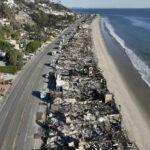In fall 2016, Zurich North America moved its operations into a spectacular new 783,000-square-foot complex. Today, it is barely used, thanks to the ongoing coronavirus pandemic.
Outside, the 40-acre complex has 13 acres of native savanna landscaping, more than 600 trees, terraces, walking trails, and ponds that support swans. Natural light bathes much of the spacious indoor setup of the modernist and sculptural headquarters where 2,500 employees and contractors are meant to work. There are innovations such as sit-stand desks, enclaves for small group meetings, social hubs, a coffee bar and cafeteria, and a fitness center, too. Bee hives on green roofs are harvested annually for honey and wax (made into lip balm and candles) for employees to enjoy.
Right now, only 100 or so employees or managers are in the complex at any given time. The rest have been working from home since the COVID-19 pandemic began in March.
“It always comes back to the health and safety of employees. If somebody got COVID, we’d feel terrible,” Paul Noffke, head of Zurich North America Business Services, told Carrier Management. “We are driven to make it as safe as we possibly can. Right now, it is not safe to have gatherings and that’s the number one thing.”
When COVID-19 struck, corporations across the United States and around the world sent their employees to work from home as pandemic shutdowns spread. Then, the expectation was that offices could reopen in just a few months. Several months later, corporate office shutdowns for insurers and other industries are stretching out to the end of 2020 and beyond.
Zurich North America was hoping to have employees return to its offices by July and then September 2020, but now that delay will last at least until February 2021, according to Bob Boyle, North America chair of Zurich’s Crisis Management Committee.

Insurers have had to adjust and adapt quickly.
Like most employers, Nationwide, for example, initially moved the vast majority of its employees (28,000) to temporary work-from home status when the pandemic began. In April, it announced it would permanently transition to a hybrid operating model with most of its employees working in four main campuses (downtown Columbus and Grandview Yard, Ohio; Des Moines, Iowa; Scottsdale, Ariz.; and San Antonio, Texas). Plans were to exit permanently buildings in Florida, Pennsylvania, North Carolina, Wisconsin, and move those associates to permanent-work-from-home status by November, a target that is “generally on track,” according to a company spokesperson.
But as the pandemic continues its advance, returning employees to the office remains a fluid target date. The Nationwide spokesperson said there are “tentative” plans to return associates to their offices in early 2021, but “those plans are in pencil with associate health and safety in mind.” Once that happens, about 30 percent of Nationwide’s total staff will work from home.
Other companies with a more global presence plotted earlier returns.
In July, Chubb’s 31,000 global employees began a return to their offices in many countries at a rate of 20 percent to 50 percent or more, depending on the global location and degree that the pandemic was under control, Chubb CEO Evan Greenberg noted during the company’s 2020 second quarter earnings call. U.S. office were more halting because U.S. conditions hadn’t stabilized as much as other nations at that time. Now that the pandemic is worsening globally again, Chubb’s full global return to the office, as with other companies, remained in question. Chubb could not be reached for comment.
It remains to be seen how many employees at Zurich North America, or companies in general, will want to return to the office once the pandemic passes. Approximately 76 percent of global office workers and 82 percent of U.S. office workers want to keep working from home at least part of the time when the pandemic is over, according to the Iometrics/Global Workplace Analytics’ Work-From-Home Experience Survey released in June. About 16 percent globally – 19 percent in the U.S. – said they want to stay away from the office forever.
Skeleton Crew
Like their insurance industry peers, Zurich North America has taken a deliberate approach toward reopening its headquarters – whenever that date will be – by reorganizing office space, developing office safety protocols and closely following the COVID-19 infection numbers.
“We’ve been making our decisions on coming back based on the data, trying to be data-focused versus opinion-focused, always with the safety of employees in mind,” said Noffke, who is also working from home.
That means that Zurich North America continues to let in only essential workers – about 100 each day – working in areas such as the company’s document logistics center where technicians image mail and forward to employees at home, allowing them to keep current with their work. Some workers come in to deal with claims processing, perhaps working on a specific large claim where viewing their files is necessary.
“It varies from day to day,” Noffke said. “Most of our claims people may be able to work from home, but occasionally they need physical documents from their desk and they go in.”
David Yanda, general manager of Zurich North America’s headquarters building and an essential employee, said there’s also about 40-50 people from the building’s custodial and engineering staff and security who come in each day, to keep the building itself functioning properly.
Safety Precautions
In the interim, Zurich North America has worked to adapt its offices to COVID-19 safety concerns both for its skeleton crew, and for office workers who will eventually return in force.
According to Noffke and Yanda, changes include:
- Every employee must take his or her temperature at home before they come in. If employees’ temperature is above 100.4 or they don’t feel well, they’re asked not to come in.
- Employees in the office must wear masks unless sitting at their desks. If they move around or stand at a sit/stand desk, they must have their masks on.
- Safe distance signage has been placed at workstations. An outside third party also helped measure distances between work stations in order to adapt desk distances and floor plans (as well as conference room layouts), both in Zurich’s U.S. and Canada offices.
- Containers of hand sanitizer are located throughout the building, in social hubs, by elevators and in bathrooms.
- Disinfectant wipes are placed in every office and work station.
- The company marked off 7 feet 6 inches at strategic areas throughout its complex, at bathrooms, elevators and other social hubs, with the larger space designed to account for different people sizes.
- Only one person is allowed in an elevator at a time.
- Private offices in the complex’s various enclaves are restricted to one person only.
- Larger conference centers (there are 33 rooms) will be face strict use limits, though discussions are ongoing.
- There are plexiglass and sneeze guard setups at the front reception desks.
Beyond that, each Zurich North America employee received a safety kit over the summer, with a Zurich-branded mask, a no-touch tool with a hook and rubber pointer that allows for opening of doors, elevator buttons and more.
“We’re trying to cut down on things they may have to touch, Noffke said.
Employees also get a lunch box and ice pack in their kits, because Zurich North America won’t be opening up fridges or freezers for the time being.

“We are asking [employees] not to bring their lunch to put in the refrigerator, in the beginning,” Noffke said. “We want them to stay at their desks and minimize the amount of moving around.”
For employees working at home, Zurich managers encouraged them to work with their health and safety officer to do a virtual assessment of their home office environment, submitting pictures depicting how they work. More than 500 participated, and Zurich shipped unused ergonomic desk chairs to many staff at their homes, Noffke said.
Safe, or Not?
Of course, people can return to a building, but how do you reassure employees that the air is safe to breathe and not a COVID-19 threat?
Yanda said his team is using a high grade of air filter for its smart ventilation system, and has also programmed it to double the amount of fresh air that comes through the building. Before COVID-19, 10 percent of air came from outside, but that’s now been upped to 20 percent. As well, outside air now flows through the building 24 hours a day, as opposed to just during work hours.
Additionally, Noffke and Yanda noted, the company now uses hospital grade disinfectant to clean all touch points, and cleaning crews now come in during the work day as opposed to at the end of the work day.
As well, for essential workers – in the mailroom and documents center – all must get up, leave and take a lunch break once per day in the middle of their shift. Once they do so, cleaning staff “completely disinfect touch points.”
Noffke and Yanda said they consider themselves lucky, working at a relatively new headquarters with lots of space and room, so radical layout or protocol changes haven’t been necessary.
According to Noffke, the changes weren’t overly expensive, though he acknowledged more adaptation may be necessary depending on how many employees want to return to offices and their desks when the reopening process begins.
“That is an open question,” he said. “Right now we think we have enough space to accommodate everybody.”

For the foreseeable future, Noffke said the company is trying to make sure its staff feels safe and happy working from home. So far it has been working.
“We’ve been so successful at working from home … and [employee productivity] statistics, their measurements are as good if not better than when they were in the office,” Noffke said. “Long-term, will that continue? We just haven’t tackled that issue yet. We’re starting to look at it but it is so early-on, it’s hard to guess.”
Missing the Swans and the Bees
Zurich North America employees working from home missed the swans in the front pond, as well as the five baby cygnets they had this year. According to Noffke, Yanda and a colleague took pictures and posted one on the company’s internal news site.
“I can’t even tell you how many likes it got,” Noffke said.
Yanda said there is also plenty enthusiasm about Zurich North America’s honeybees, which live in two hives (three boxes per hive) – one on the headquarters’ east bar green room, and one on the west bar. The hive starts making honey in May and in subsequent months. Typically, Yanda and crew harvest the honey and jar it, and use the bee wax to make lip balm and candles (all labeled with the Zurich brand) – with the finished products sold to employees and the money going to charity. Employees can also take workshops to learn how to tend to the hives.
This year, that’s not possible, with virtual workshops in the mix instead.
“There are great people at Zurich,” Noffke said. “My colleagues are just so much fun to work with.”
But without everyone working in the same space, Noffke added “I do miss it.”





















 Lawsuits Accuse Insurers of Colluding to Drop Coverage in Fire-Prone Areas of California
Lawsuits Accuse Insurers of Colluding to Drop Coverage in Fire-Prone Areas of California  AIG: Turning One Human Underwriter Into Five, ‘Turbocharging’ E&S
AIG: Turning One Human Underwriter Into Five, ‘Turbocharging’ E&S  Severe Midwest Storms Result in Baseball Size Hail
Severe Midwest Storms Result in Baseball Size Hail  Class Action Accuses Toyota of Illegally Sharing Drivers’ Data With Progressive
Class Action Accuses Toyota of Illegally Sharing Drivers’ Data With Progressive 





